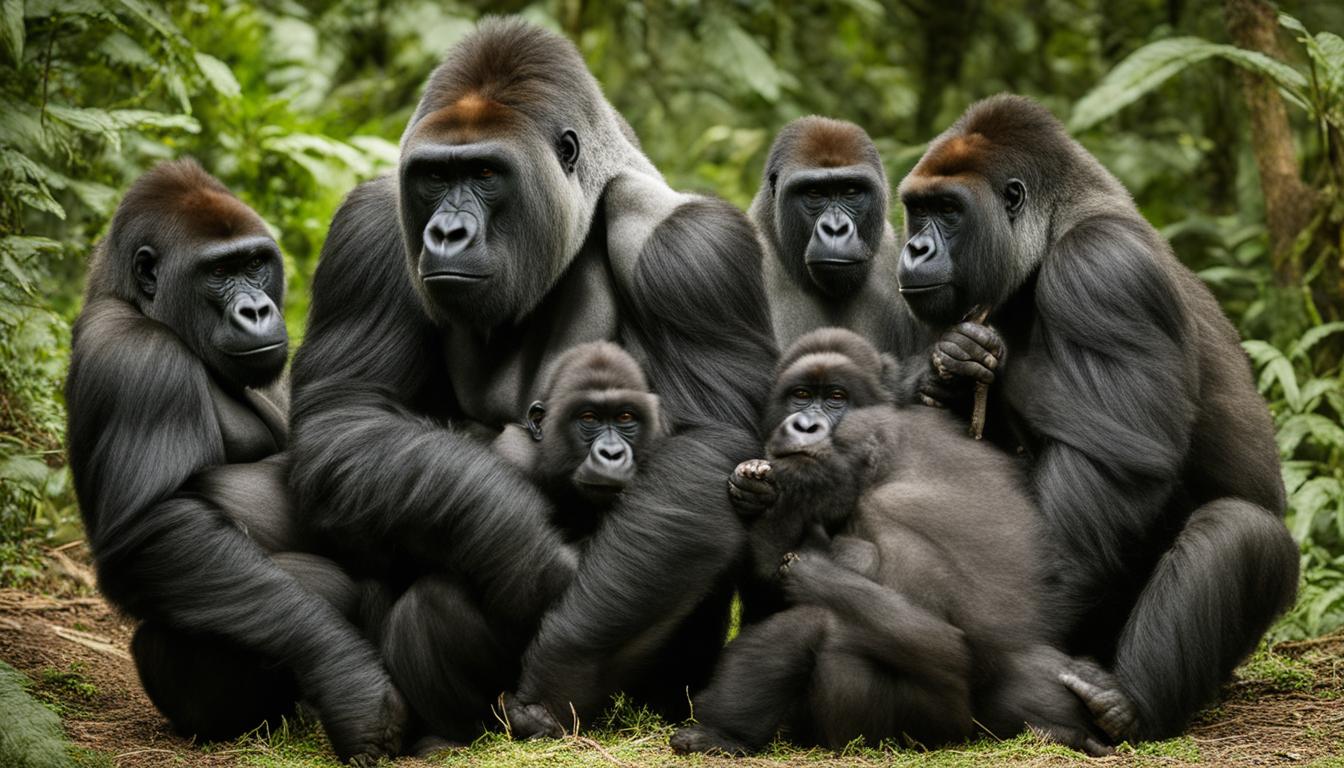Gorilla family structure, gorilla social structure, and gorilla group dynamics play a crucial role in understanding the fascinating lives of these incredible primates. In this article, we will explore the intricate relationships and organization within gorilla families in their natural habitat.
Gorillas, as social animals, live in groups known as troops. These troops consist of 2 to 30 members, including adult males, blackbacks, adult females, and their offspring. The leader of the group, known as the “Silverback,” is the oldest and strongest male who has exclusive mating rights with the females. He guides the troop and ensures their safety and well-being.
The average group size ranges between 2 and 12 members, and they move within an area of 4 to 25 square kilometers, establishing their territory. Gorilla families often experience changes in composition due to factors like death and migration, which influence the dynamics within the group.
Understanding the structure and dynamics of gorilla families provides insight into their social behavior and hierarchy. Join us as we delve deeper into the male dominance, female power dynamics, and infant care within these majestic creatures in subsequent sections of this article.
Male Gorilla Dominance and Female Power Dynamics
Gorilla troops are structured around a dominant male known as the silverback. This powerful and charismatic leader is easily recognizable by the patch of silvery fur on his back. The silverback is responsible for making important decisions, resolving conflicts within the group, defending the troop from potential threats, and ensuring the survival of the group through mating and reproduction. He holds exclusive mating rights with the females in the troop, protecting them and their offspring from other males.
In some cases, there may be another adult male in the troop who functions as a second-in-command to the silverback. However, this subordinate male is always under the authority of the leader. The presence of multiple silverbacks within a group can sometimes lead to power struggles and conflicts, as each male strives to establish and maintain dominance.
Female gorillas in the troop do not compete for dominance like their male counterparts. Instead, they organize themselves in a hierarchical structure based on the order in which they joined the troop. The females who have been with the troop the longest hold higher status and have more influence within the group. Newcomers must navigate their way into the established hierarchy and earn their place among the females.
In gorilla troops, male dominance is clear, with the silverback leading the group and having exclusive mating rights. Female power dynamics are based on the time of arrival, with longer-standing females holding higher status. This complex social structure ensures the stability and survival of the troop.
In summary, male gorilla dominance and female power dynamics play a crucial role in the social structure of gorilla troops. The silverback leads the group, making decisions, resolving conflicts, and protecting the females and their offspring. Female gorillas organize themselves in a hierarchy based on their time of arrival, with longer-standing females having higher status. This intricate balance ensures the survival and stability of gorilla families in the wild.
Gorilla Family Composition and Infant Care
Gorilla families in the wild have a dynamic composition that changes over time. Males and females typically leave their birth groups once they reach sexual maturity, preventing inbreeding and promoting genetic diversity. Adolescent males often form bachelor groups until they are old enough to acquire their own females. Female gorillas, on the other hand, usually join a lone silverback or a newly formed troop. Late arrivals to established groups do not receive the same benefits as higher-ranking females, so they opt for alternative options.
Within gorilla families, mothers play a crucial role in infant care. They form strong bonds with their offspring, providing constant care and protection during the first three years of life. Mothers teach their young ones essential skills, such as foraging and nest-building. Infant gorillas rely heavily on their mothers for nourishment and guidance, learning the social behaviors necessary for their survival in the group. This close relationship between mother and offspring fosters a sense of security and aids in the development of the young gorilla’s independence.
Understanding the composition of gorilla families and the intricate dynamics involved in infant care provides valuable insights into the social lives of these incredible primates. It highlights the importance of genetic diversity in maintaining healthy populations and emphasizes the critical role that mothers play in nurturing the next generation. By studying gorilla family structures and observing their behaviors in the wild, researchers gain a deeper understanding of these remarkable animals and their fascinating social interactions.
| Gorilla Family Composition | Infant Care in Gorilla Groups |
|---|---|
| Males and females leave their birth groups once they reach sexual maturity. | Mother gorillas provide constant care and protection for their offspring during the first three years of life. |
| Adolescent males often form bachelor groups before acquiring their own females. | Mother gorillas teach their young ones essential skills for survival, such as foraging and nest-building. |
| Female gorillas join a lone silverback or a newly formed troop, avoiding established groups where they have lower status. | Infant gorillas rely heavily on their mothers for nourishment and guidance. |
Gorilla Troop Hierarchy and Social Behavior
Gorilla troops, led by the dominant silverback, exhibit a complex social structure characterized by a clear hierarchy and fascinating social behavior. The silverback, easily recognizable by the patch of silvery fur on his back, assumes the leadership role within the troop. He makes important decisions, resolves conflicts, and defends the group from external threats. The silverback also has exclusive mating rights with the females, ensuring the survival of his genetic lineage.
Within the troop, adult females compete for proximity to the silverback as it provides additional protection for themselves and their offspring. Female gorillas organize themselves in a hierarchy based on their seniority in joining the troop. First-arriving females have higher status and enjoy certain privileges compared to those who join later. This social hierarchy among the females helps maintain stability and reduces conflict within the group.
Gorilla troops typically consist of 2 to 12 individuals, with synchronized activity patterns. They spend a significant portion of their day feeding and foraging, with peak feeding activity observed in the morning and afternoon. Gorillas construct nests to sleep in, with each individual building their own nest. This behavior ensures individual comfort and reduces the risk of predation during the night.
| Gorilla Troop Hierarchy | Behavior |
|---|---|
| Dominant Silverback | Makes decisions, resolves conflicts, and defends the group |
| Female Gorillas | Compete for proximity to the silverback for protection |
| Group Size | 2 to 12 individuals with synchronized activity patterns |
| Feeding Behavior | Peak feeding activity in the morning and afternoon |
| Nesting Behavior | Each individual builds their own nest for sleep |
Understanding the gorilla troop hierarchy and social behavior provides valuable insights into the intricacies of their group dynamics. It highlights the importance of the dominant silverback in leading and protecting the group, while also shedding light on the competitive nature of female gorillas for favorable positions within the troop. By studying these behaviors, researchers gain a better understanding of these magnificent creatures and their natural habitats.
Conclusion
Gorilla families in the wild have a fascinating structure that is shaped by their social behavior, hierarchy, and group dynamics. The dominant silverback plays a crucial role in leading the troop, making decisions, and protecting the group. Other adult males may also hold positions of authority within the troop. Female gorillas establish a hierarchy based on their arrival time, with earlier arrivals holding higher status.
These gorilla families live in close-knit units, where mothers provide exceptional care and protection for their offspring. The bond between mother and infant is particularly strong during the first three years of life. These nurturing behaviors contribute to the overall well-being and growth of the young gorillas.
Gorilla troop populations can vary in size, ranging from small groups to larger troops. Within these troops, synchronized activity patterns are observed, and gorillas spend a significant amount of time feeding and foraging. They construct their own nests to sleep in, reflecting their individual preferences and behaviors.
Understanding the intricate structure and dynamics of gorilla families gives us a deeper appreciation for the complex social lives of these magnificent primates in their natural habitats. From the hierarchy within the troop to the care provided by mothers, every aspect contributes to the success and survival of the gorilla family. Exploring these aspects of gorilla society enhances our understanding and connection with these incredible creatures.
How Does Gorilla Family Structure Impact Conservation Efforts?
The gorilla family structure plays a crucial role in gorilla conservation success stories. Strong familial bonds help gorillas thrive in their natural habitat and increase the chances of successful conservation efforts. Understanding and protecting these family dynamics are essential for the long-term survival of gorilla populations.
FAQ
What is the structure of gorilla families in the wild?
Gorilla families in the wild have a complex structure that is based on social behavior, hierarchy, and the dynamics of the group.
How does male gorilla dominance and female power dynamics work?
The dominant silverback leads the troop, with other adult males potentially serving as second-in-command. Female gorillas organize themselves in a hierarchy based on the time they joined the troop.
How is the composition of gorilla families determined and how is infant care provided?
Male and female gorillas usually leave the group they were born in and join other groups after reaching sexual maturity. Mothers in gorilla families provide care and protection for their offspring.
What is the hierarchy and social behavior within gorilla troops?
Gorilla troops are typically led by the dominant silverback, who makes all the group decisions and receives the dominant portion of food. Adult females in the troop compete for the opportunity to be close to the silverback.
What are the key aspects of gorilla family structure, troop hierarchy, and social behavior?
Understanding the structure and dynamics of gorilla families helps us appreciate the complex social lives of these fascinating primates in their natural habitats.











